Keywords
|
| DC-link voltage control, Permanent Magnet Synchronous Generator(PMSG) wind turbine, Maximum power point tracking, voltage source converter (VSC). |
INTRODUCTION
|
| Worldwide fast depletion of conventional energy resources necessitates the implementation of renewable energy sources for generation to satisfy the growing demand. Since last decade, technological innovations and a changing economic and regulatory environment have resulted considerable revival of interest in connecting various renewable energy resources as a source of distributed generation to the grid. The amount of grid connected wind power has increased enormously during last decade. This penetration of wind energy in power systems will increase and they may begin to influence overall power system behavior and possess new challenges to engineers as these have a significant impact on the grid system and equipment operations in terms of steady state, dynamic operation, reliability, power quality, stability and safety for both the utility and customers. This situation has to be investigated in order to sustain power system operation. |
| The variable speed wind turbine with a multipole PMSG[1] and full-scale/fully controllable voltage source converters (VSCs) is considered to be a promising, but not yet very popular, wind turbine concept . The advantages of such a PMSG configuration are 1) gearless construction ; 2) the elimination of a dc excitation system ; 3) full controllability of the system for maximum wind power extraction and grid interface; and 4) ease in accomplishing fault-ride through and grid support . Therefore, the efficiency and reliability of a VSC-based PMSG wind turbine is assessed to be higher than that of a DFIG wind turbine. Due to the intensified grid codes, a PMSG wind turbine with full scale VSC-based insulated gate bipolar transistor (IGBT) converters is becoming more and more favored by the wind power industry . |
| Shuhui Li et al[1] investigates both the conventional and a novel vector control mechanism for a PMSG wind turbine that has two side-by-side voltage source pulse width modulation converters. The proposed approach is based on a direct current vector control mechanism for control of both machine and grid-side converters of a PMSG wind turbine. Then, an optimal control strategy is developed for integrated control of PMSG maximum power extraction, reactive power, and grid voltage support controls. |
| Alka Singh et al[2] presented the benefits of distributed energy sources which include long term energy security, decentralized supply for benefit of rural population, and how DG’s meet country’s ever increasing energy demand.It also discusses the need to incorporate renewable energy sources to grid/electric power supply, several issues and guidelines needed to be met before interconnection. Further modelling, simulation and performance of an interface device modelled as voltage source inverter with a battery at the DC link (BESS) which is one of the most promising storage technology for interfacing renewable resource such as solar,wind etc at the dc link is discussed. |
| T.R. Ayodele et al[3] presented various challenges posed to the power system planners and the utility operators in terms of the power system grid integrity i.e. power system security, power system stability and power T.R. Ayodele et al[3] presented various challenges posed to the power system planners and the utility operators in terms of the power system grid integrity i.e. power system security, power system stability and power |
| S.Vijayalakshmi et al[4] presented the modelling of a variable speed wind turbine with a permanent magnet synchronous generator and implemented in MATLAB/Simulink inorder to validate its torque-speed and wind- speed characteristics.Further the concept of the maximum powerpoint tracking has been presented in terms of the adjustment of the generator rotor speed according to instantaneous windspeed. |
| F.Blaabjerg et al[5] discusses the applications of power electronics for the wind turbine technology. The applications of power electronics in various kinds of wind turbine generation systems and offshore wind farms are also illustrated, showing that the wind turbine behavior/performance is very much improved by using power electronics. Further how power electronics are able to act as a contributor to the frequency and voltage control by means of active and reactive power control is also presented. |
| G.Ravi Kumar et al[6] presented a method for placement of different types of filter in IEEE 13 bus industrial distribution system for estimation and minimization of harmonics .Two types of filters (Single tuned filter & double tuned filter) were modelled and the THD was calculated before and after the filter was connected. |
| Sharad W.Mood et al[7] presented the performance of the wind turbine and their power quality issues are determined on the basis of measurements according to the guidelines specified in International Electro-technical commission, IEC 61400-21.The pulse width modulation (PWM) inverter scheme for the grid connected wind energy generation for power quality improvement is simulated in MATLAB/SIMULINK and the scheme for improvement in power quality has been presented. |
| Benjamin Krposki et al[8] examines the system integration issues associated with DG systems and the benefits of using power electronic interfaces for such applications. Further how power electronic interfaces provide flexibility in operations with various other DG sources, and how they can potentially reduce overall interconnection costs through standardization and modularity are discussed. |
| In this paper direct current vector control is used for controlling the machine side converter and grid side converter of PMSG wind turbine and a filter is employed before interconnecting the system to grid and the power quality of the grid voltage is assessed at the point of common coupling by measuring the THD and it is within acceptable limits. |
SYSTEM CONFIGURATION AND PRINCIPLE OF OPERATION
|
| The system configuration of a direct drive PMSG based grid interfaced WECS is shown in Fig 1. A horizontal axis wind turbine is used to drive the PMSG. A salient pole type PMSG is used. The kinetic energy present in the wind is converted into the mechanical torque using a wind turbine. Mechanical energy is converted into electrical energy using a PMSG. To facilitate variable speed operation for achieving MPPT, the PMSG cannot be interfaced with the grid directly. Therefore, two VSCs are used in back to back configuration with common DC link known as a MSC and a GSC. These VSC’s are controlled independently. Pulse width modulation technique is used to control these VSC’s. The midpoint of each leg of a GSC is connected to each phase of grid supply through an interface inductor. The MSC controls PMSG currents in a desired phase, frequency and magnitude to achieve MPPT. The GSC is synchronized with the grid unlike a MSC. |
| The reactive power and an active power exchange with the grid are function of phase and amplitude of terminal voltage at AC terminals of a GSC. The objective of controlling a GSC is to keep constant DC link voltage under change in generated active power while keeping sinusoidal currents of PMSG. If Vdc is maintained constant at its reference value and keeping the modulation index of load side inverter at a fixed value, the amplitude of output ac voltage can be controlled and maintained at the rated voltage .The relation between dc voltage and output ac voltage of three-phase pulse width modulation (PWM) inverter is given by |
 |
| Where VLL1 is Fundamental phase-phase root-mean-square (rms) Voltage on the ac side, K is Fundamental phase-phase root-mean-square (rms) Voltage on the ac side, Vdc is the dc link voltage. |
WIND TURBINE MODEL
|
| Wind turbine captures power from the aerodynamically designed blades and converts it into rotating mechanical power.Following equations[4] are used to model the wind turbine. The kinetic energy of the wind (air mass m,wind speed v) is given by the following equation |
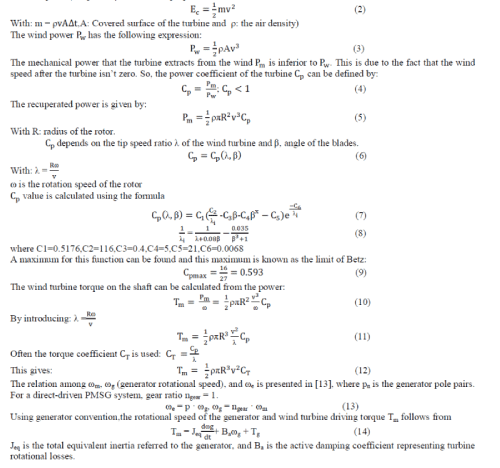 |
DIRECT CURRENT VECTOR CONTROL OF MSC AND GSC
|
| The direct-current vector control technology [1]is a vector control technology that has been developed recently for control of the synchronous generator only in a variable-speed PMSG wind turbine and for control of a VSC-based HVDC system. Compared to the conventional vector control strategies, direct-current vector control has demonstrated many advantages in those applications, such as enhanced system stability, reliability, and efficiency. This paper presents mechanisms for optimal control of a PMSG wind turbine system under a direct-current dq vector control configuration. Then, based on the proposed control structure, the overall control functions of a PMSG system are developed, including maximum power extraction control, dc-link voltage control, reactive power control, and grid voltage support control. |
| A.GENERATOR MODEL(MSC) |
| Dynamic modelling of PMSG can be described in d-q reference frame as follows [1] |
 |
 |
| Where, Vsd and Vsq are the d and q components of instant stator voltage,Rs is the stator resistance, Ld and Lq are the inductances of the generator on the d and q axis, isd and isq are the stator d and q axis currents, Ψf is the permanent magnetic flux. In order to complete the mathematical model of the PMSG, the expression for the electromagnetic torque can be described as |
 |
| If id = 0, the electromagnetic torque is expressed as: |
| Te = 3/2 pn Ψf isq |
| The MSC controls the PMSG to achieve the following goals: maximum energy extraction from the wind and/or compliance with a control demand from the wind power plant control center. |
| The direct-current vector control strategy of the MSC, implemented through a nested-loop control structure is shown in Fig2 which includes the following three parts: |
| 1) transformation from speed control to current control; |
| 2) development of a direct-current control mechanism; and |
| 3) conversion from current control signals to voltage control signals. |
B.GSC MODEL
|
| In the GSC model DC link capacitor is on one side and a three-phase voltage source representing the voltage at the point of common coupling (PCC) of the ac system is on the other side of the converter. In the dq reference frame, the voltage balance across the grid filter is |
 |
| where ωs is the angular frequency of the grid voltage, Lf and Rf are the inductance and resistance of the grid filter, respectively, Vd, Vq,Vd1 and Vq1 represent the d- and q-axis components of the PCC voltage and GSC output voltage, respectively, and id and iq represent the d- and q-axis components of the current flowing between the GSC and the ac system. |
| In the PCC voltage oriented frame, the instantaneous active and reactive powers transferred from the GSC to the grid are proportional to grid d- and q-axis currents, respectively, as shown by [21] and [22], while the steady-state active and reactive powers are proportional to the GSC d- and q-axis output voltages Vd1 and Vq1 , respectively, as shown by [23] |
 |
| The direct-current vector control strategy of the GSC is implemented as shown in Fig.3 through a nested-loop controller in the following way: |
| 1) transforming the dc-link voltage and reactive power control to d- and q-axis current control; |
| 2)developing a direct current control scheme; and |
| 3) converting current control signals to voltage control signals . |
TEST SYSTEM
|
| This test case consists of 13 buses and is representative of a medium-sized industrial plant. The system is extracted from a common system that is being used in many of the calculations and examples in the IEEE Color Book series . The plant is fed from a utility supply at 69 kV and the local plant distribution system operates at 13.8 kV. The system is shown in Fig4 . Due to the balanced nature of this example, only positive sequence data is considered for modelling.Capacitance of the short overhead line and all cables are neglected. Transformer data, line data are used from [9] for modelling the system. |
SIMULATION STUDY AND RESULTS
|
| Wind turbine is modelled using equations(2) to (12) as shown in Fig9 with wind velocity as a step signal varying from 7 to 12 m/s with a step change at 5 secs representing variable wind speed and the mechanical torque output is given as input to permanent magnet synchronous generator. Data used for modelling wind turbine and PMSG ratings are given in Appendix. MSC and GSC are modeled using equations (15)-(23) as shown in Fig6 thereby achieving operation of PMSG wind turbine at maximum power point, maintenance of constant dc link voltage, reactive power absorbed from the grid is also controlled. |
| Thus from Fig14 and 15 it is clear that grid current and PMSG stator output current has reached the steady state and nearly 1p.u following a step signal change(change in wind velocity) at 5 secs indicating the effective performance of the MSC and GSC. |
| Thus the real power tracks the maximum power output from the wind turbine and reactive power drawn from the grid is nearly zero which can be realized from Fig 17 and 18. |
CONCLUSION
|
| Thus it can be seen that for grid connected direct driven PMSG with direct current vector control mechanism maximum power point tracking is done to extract maximum power from the wind by speed control of MSC, maintenance of constant DC link voltage and control of reactive power absorption from grid is achieved by d- and qaxis control of GSC. The harmonic spectra of grid voltage when PMSG with wind turbine is interconnected to the grid as a source of distributed generation is shown in Fig22 from which it can be observed that the Total Harmonic Distortion (THD) is 5.78% which is within acceptable limits as per IEEE-519-1997 standards. |
APPENDIX
|
PMSG DATA
|
| Rated Power= 1.5MVA, Rated Voltage= 575 V, Stator Resistance Rs= 0.006 ohm,Stator Inductances Ld,Lq=0.3e-3 H, Number of Poles= 48,Flux linkage= 1.48 V.s,Rated Speed= 125 rpm |
WIND TURBINE DATA
|
| Wind Speed =7-12 m/s, Blade radius=33 m |
| Grid side coupling impedence R,L=0.03(ohm), 0.3H |
| DC Link voltage =1150 V |
Figures at a glance
|
 |
 |
 |
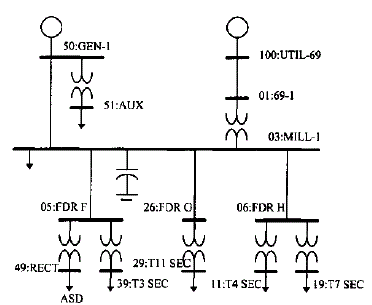 |
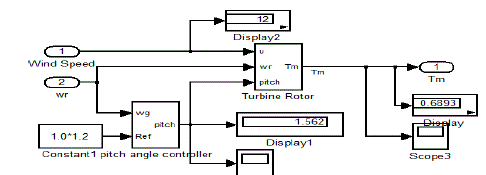 |
| Figure 1 |
Figure 2 |
Figure 3 |
Figure 4 |
Figure 5 |
|
 |
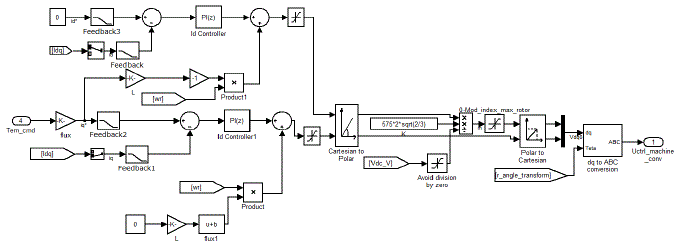 |
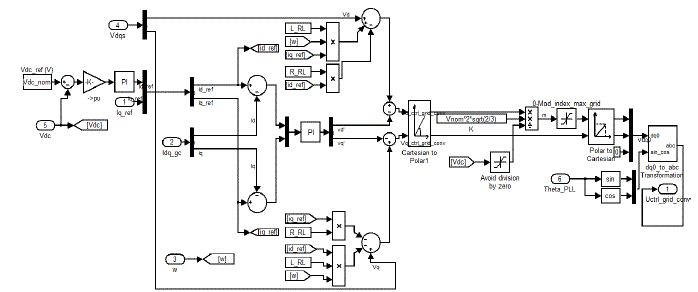 |
 |
 |
| Figure 6 |
Figure 7 |
Figure 8 |
Figure 9 |
Figure 10 |
|
 |
 |
 |
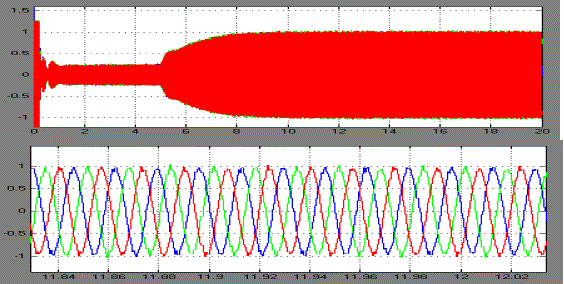 |
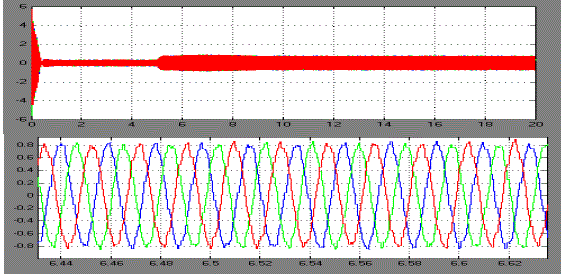 |
| Figure 11 |
Figure 12 |
Figure 13 |
Figure 14 |
Figure 15 |
|
 |
 |
 |
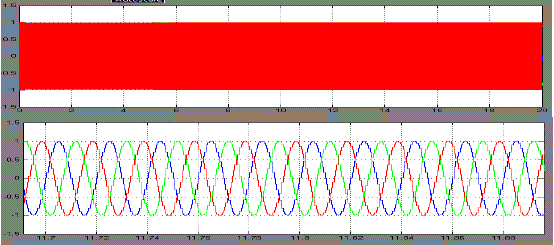 |
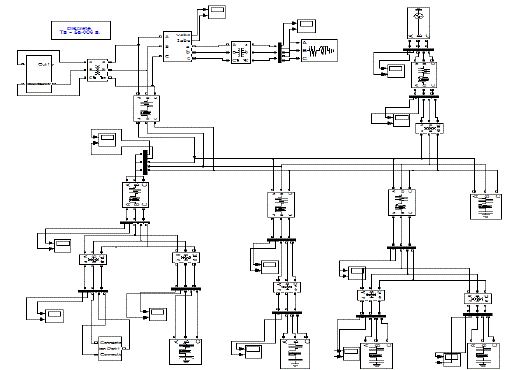 |
| Figure 16 |
Figure 17 |
Figure 18 |
Figure 19 |
Figure 20 |
|
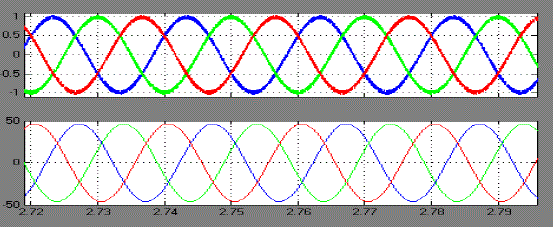 |
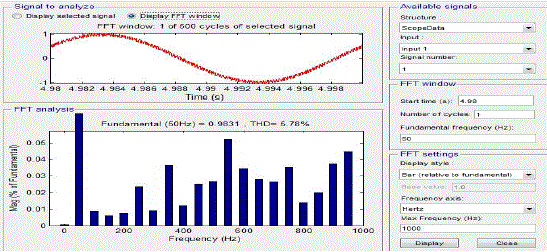 |
| Figure 21 |
Figure 22 |
|
References
|
- Shuhui Li, Timothy A. Haskew, Richard P. Swatloskis,and William Gathings, “Optimal and Direct-Current Vector Control of Direct-Driven PMSG Wind Turbines”, IEEE Transactions on Power Electronics, Vol.27, No.5, May 2012.
- Alka Singh, Bhim Singh, “Power Quality Issues related to Distributed Energy Source Integration to Utility Grid”, Annual IEEE India Conference (INDICON) 2010.
- T.R. Ayodele, A.A. Jimoh, J.L Munda, J.T Agee, “Challenges of Grid Integration of Wind Power on Power System Grid Integrity” , International journal of renewable energy research , Vol.2, No.4, 2012 .
- S.Vijayalakshmi,Sasikumar,Saravanan,R.V.Sandip, Vijay Sridhar, “Modelling and control of a wind turbine using PMSG”, International Journal of Engineering Science and Technology(IJEST), Vol.3 No.3 March 2011, ISSN:0975-5462.
- F. Blaabjerg, Z. Chen, R. Teodorescu, F. Iov, “Power Electronics in Wind Turbine Systems”, IEEE Conference(2006)
- G.RaviKumar,M.Lokya,T.Vijay Muni, “Estimation and Minimization of Harmonics in IEEE 13 Bus Distribution System”, International Journal of Engineering Research & Technology (IJERT),Vol. 1 Issue 7, September – 2012,ISSN: 2278-0181.
- MirzaMohd.Shadab,AbuTariq,“Performance analysis of permanent magnet synchronous generator connected with wind turbine” ,International Journal of Advanced Technology & Engineering Research (IJATER) Vol 2, Issue 2, May 2012 ,ISSN NO: 2250-3536.
- Benjamin Kroposki, Christopher Pink,RichardDeBlasio, Holly Thomas,MarceloSim˜oes, Pankaj K. Sen, “Benefits of Power Electronic Interfaces for Distributed Energy Systems” IEEE Transactions on energy conversion, Vol.25, No.3 September 2010.
- “Test Systems for Harmonic Modelling and Simulation” ,IEEE Transactions on Power Delivery,vol 14,No 2, April 1999.
- PriyankaSingh ,S.M. Tripathi ,Ankit Dixit ,Nikhil Mishra, “Recent trends in power converters for wind energy conversion system with grid integration impact” IJREAS Volume 2, Issue 2 (February 2012) ISSN: 2249-3905.
- S.N.Bhadra,D.Kastha, S.Banarjee , “Wind Electrical Systems”.
- Muhammad H.Rashid , “Power Electronics Handbook”,2007.
- R.Krishnan , “Electric Motor Drives,Modelling,Analysis, and Control”,2009.
- ArindamGhosh, “Power Quality Enhancement Using Custom Power Devices”.
- P.Kundur, “Power System Stability and Control”,1994.
|